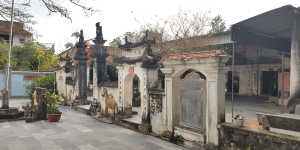
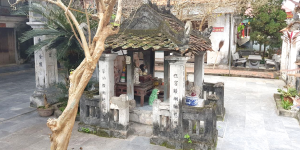
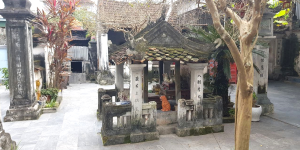
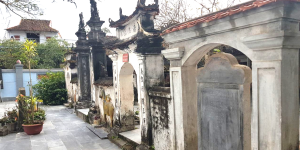
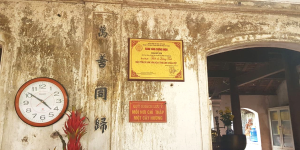
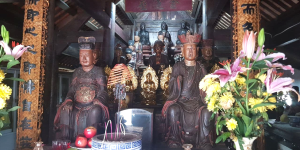
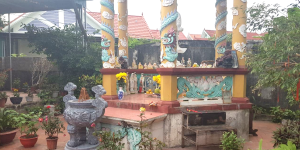
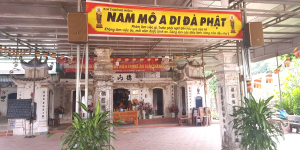
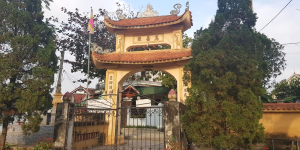
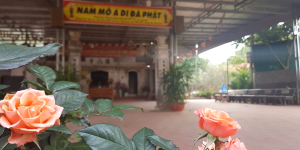
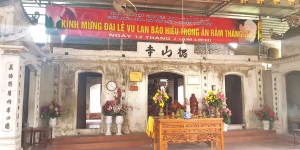
Camera tour
Price: Free
Time to visit a place: 120 phút
Open Time: 7:00 AM - Close Time: 6:00 PM
Address: Nam Dan Town, Nam Dan District, Nghe An Province
DUC SON PAGODA
Located in Van Dien commune, Nam Dan district, far from Vinh city - Economic and political center of Nghe An province about 22km to the west, according to folklore to each other, Duc Son pagoda was built in the Tran Dynasty, on a land steeped with historical imprint. This land was formerly the place where King Mai Thuc Loan stationed his capital, built Van An citadel to fight the invaders of the Tang Dynasty in the 8th century, where the second princess of King Le Trang Tong chose to take refuge when fleeing. Around the pagoda is a dense system of relics such as Duc Nam communal house, Duc Nam temple, Ho Son temple..., especially, right next to the pagoda is an ancient temple that coexists in parallel, that is Duc Son temple. This is the clearest evidence for the cultural tradition of Van Dien land in particular and Nam Dan in general.
Buddhism was introduced to our country very early by many different ways. During the Tran Dynasty, Buddhism was recognized as the national religion, which was the condition for the birth and development of pagodas. Duc Son Pagoda was built in that situation. At this time, the pagoda was not only a place for religious activities but also a meeting and entertainment place for the villagers. Some monks even opened teaching classes at the pagoda. Especially, while most village pagodas in Nghe An province in general and Nam Dan district in particular did not have an abbot, this pagoda has always had the presence of monks. This once again confirmed the prevalence of Buddhism here.
With a total area of 1,202m2, including works such as the gate, the altar of forsanke spirits, dharma hall, hexagonal house, lineage hall, Ha pagoda, Thuong pagoda, Duc Son pagoda are decorated according to the Mahayana sect, includes the following characters:
Buddha Shakyamuni is the son of Tinh Phan vuong - King of Kapilavastu (a small country in ancient India). Legend has it that he was an intelligent and talented person, with 32 good signs, a round face like a moon's rim, a high nose, bright eyes, a wide mouth, long ears, and a swastika seal on his chest. At the age of 29, he left his home to become a Buddhist monk but he did not follow the right method, so there was no result. When he realized that from a life of material abundance, gratification of desires and an ascetic life, mortification all deviated from the right path, he came under Bodhi Tree and sat in meditation. On the 49th day, he attained enlightenment. Since then, for 45 years, the footprints of Buddha and his disciples had traveled all over India, bringing the light and wisdom of the Buddha Dharma to teach sentient beings. At the age of 80, he passed away. His body was cremated and divided among several countries for worship.
Amitabha Tam Ton is often called the Western Three Saints, including Amitabha Buddha in the middle, Avalokitesvara Bodhisattva on the left and Dai The Chi Bodhisattva on the right. According to Buddhist teachings, there is a world called Western Ultimate Bliss, where Amitabha Buddha is the leader, preaching the Dharma to save sentient beings. Avalokitesvara Bodhisattva is a Bodhisattva who has compassion, saves suffering and rescues, is expressed in many different forms, at Duc Son Pagoda, she transforms into "Quan Am Tong Tu". Dai The Chi Bodhisattva in the Land of Ultimate Bliss to join Amitabha Buddha and Bodhisattva Avalokitesvara to lead sentient beings out of suffering and attain the perfect bliss.
In addition to the Buddhas mentioned above, there are worshiping Bodhisattva Pho Hien, Manjushri Bodhisattva, Jade Emperor, Nam Tao, Bac Dau, Thien Tu, Patriarch... at the pagoda.
Although Duc Son Pagoda was built in the Tran Dynasty, but through many restorations and embellishments, up to now, the pagoda's architecture is basically imprinted with the late Le and early Nguyen dynasties. The special thing is that through many ups and downs of history, the system of statues - the soul of the pagoda is still preserved intact. These are the sets of statues of Tam The, Di Da Tam Ton, Hoa Nghiem Tam Thanh, Monsignor - Ananda, newborn Shakyamuni, protector ... and many ancient artifacts, valuable as drums, bells, 210 scripture inscription.
With these values, in 2001, Duc Son pagoda was ranked as a national historical - architectural and artistic relic in Decision No. 53/2001/QD-BVH, on December 28, 2001 of Ministry of Culture - Information.
Distance: 900 m
Distance: 1.06 km
Distance: 1.66 km
Distance: 5.36 km
Distance: 6.11 km
Distance: 6.52 km
Distance: 7.36 km
Distance: 14.32 km
Distance: 14.80 km
Distance: 14.94 km
Distance: 15.64 km
Distance: 16.31 km
Distance: 750 m
Distance: 980 m
Distance: 1.14 km
Distance: 1.15 km
Distance: 6.77 km
Distance: 7.94 km
Distance: 8.49 km
Distance: 9.08 km
Distance: 13.93 km
Distance: 14.65 km
Distance: 15.64 km
Distance: 19.27 km
Distance: 19.41 km
Distance: 19.97 km
Distance: 0 m
Distance: 800 m
Distance: 1.28 km
Distance: 5.90 km
Distance: 7 km
Distance: 7.22 km
Distance: 7.38 km
Distance: 7.42 km
Distance: 7.44 km
Distance: 7.48 km
Distance: 7.75 km
Distance: 7.76 km
Distance: 8.25 km
Distance: 8.74 km
Distance: 8.75 km
Distance: 8.88 km
Distance: 18.10 km
Distance: 19.08 km
Distance: 19.16 km
Distance: 19.16 km
Distance: 19.40 km
Distance: 19.41 km
Distance: 19.44 km
Distance: 19.54 km
Distance: 19.72 km
Distance: 19.94 km
Distance: 19.96 km
Distance: 19.96 km


